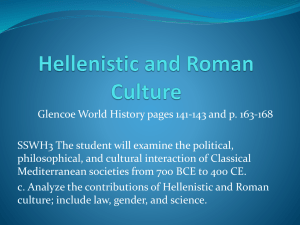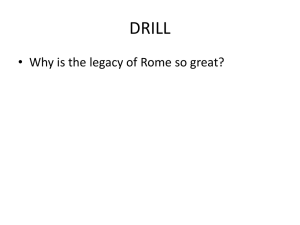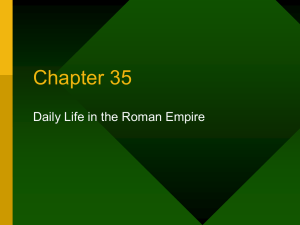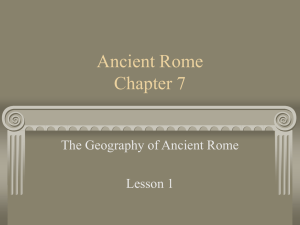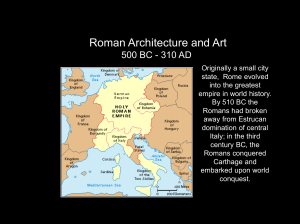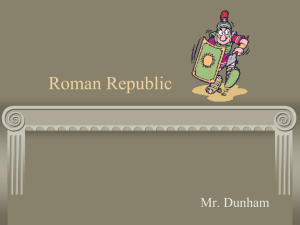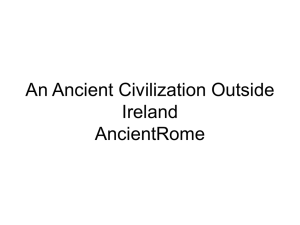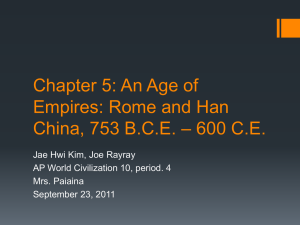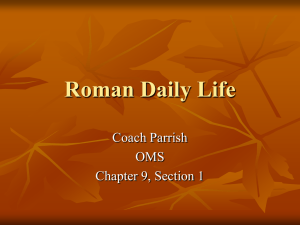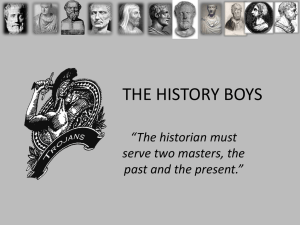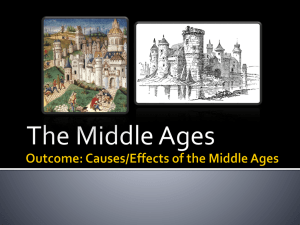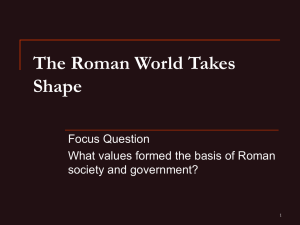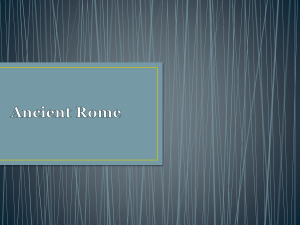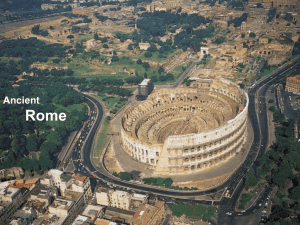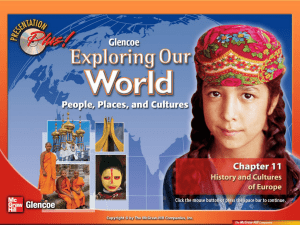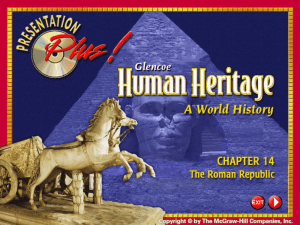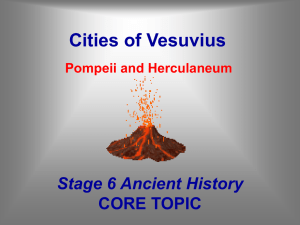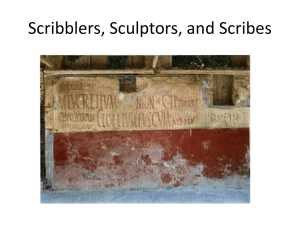Roman Empire - Portlaoise College
advertisement
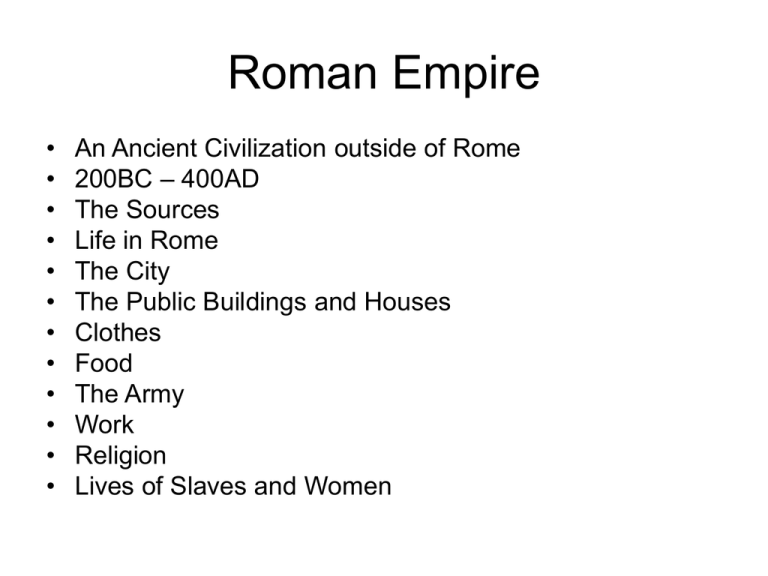
Roman Empire • • • • • • • • • • • • An Ancient Civilization outside of Rome 200BC – 400AD The Sources Life in Rome The City The Public Buildings and Houses Clothes Food The Army Work Religion Lives of Slaves and Women Rome and the land it controlled How do we know about the Romans? How do historians find out about how people lived the past? • Written sources from Cicero, Tacitus and others • Ruins of Buildings • Artifacts Artefacts Pompeii • The best source of information about daily life in the Roman Empire is Pompeii. • The city was buried under volcanic ash, and discovered by archaeologists 1500 years later. • It was a city frozen in time, bodies, paintings, shops, public baths, restaurants, even bread in ovens • Pompeii gave us thousands of artefacts • Archaeologists poured plaster into holes by the bodies and made plaster casts of the bodies • We know a great deal about how people lived from excavations at Pompeii Murals in Pompeii Key Words- Roman Towns • • • • • • • • • • Sewerage System 2 Main Streets NS, EW Grid Pattern Forum Amphitheatre Circus Public Baths Aquaducts Town Walls Main Gates Colosseum Aquaduct Circus Maximus • Grid Pattern – streets at right angles • Forum – Market Square where temples are • Amphitheatre – Circular Open-Air Arena such as the Colosseum • Circus Maximus– Stadium for Chariot Racing • Public Baths – for washing and meeting people • Aquaducts – Fresh Water Supply • Sewerage System – Drains under streets • 2 Main Streets NS, EW • Town Walls – For Defence • Main Gates – 4 or more • Insulae and domus Roman Society The rulers of Rome were called the Patricians. They lived in domus and did no physical work. Sometimes they were generals or senators Working Romans were called Plebeians. They lived in insulae and did lots of different work: carpenters, weavers, smiths, tile makers, coopers, tanners potters, etc. Educated Romans were doctors, architects and money lenders Unemployed Romans were given the dole (free grain) The lowest were the slaves, kidnapped by the Romans when they conquered a place. They did all the hard work in the cities and on the farms. A slave was a non person. We know their place in Roman society by what they wore. Toga – long white sheet Stola And Palla Clothes Tunic tied at the waste Rich ladies wore hair extensions, bracelets and necklaces • • • • • • • • • • • • Test Yourself G…….. Pattern – streets at right angles F…….…. – Market Square A…………….... – Circular Open-Air Arena Public B…….. – for washing and meeting people A…….. – Water Supply S………….. System – Drains under streets 2 Main Streets NS, EW Town ………………….. – For Defence Main Gates – 4 or more C………... M……….. - Place in Rome where chariot races were held C………….... – the name of the amphitheatre in Rome where gladiators fought T………………. are the places where the Romans went to worship their Gods. Food in Ancient Rome What Plebeians ate Breakfast? Porridge, bread, dates, olives Cena? Meat stew, bread and wine Describe a Roman Feast Who has feasts? The rich plebeians What do they eat? Lots of exotic foods, stuffed door mice and song birds, seafood, fruit and salad How do they sit? They incline on cushions What do they do if they get too full? They go to the vomitorium Who cooks and serves them? Slaves 1 million people lived in Ancient Rome • It was crowded • Land was expensive • Only patricians could afford to live in a house • The house of a patrician is called a domus • Everyone else lived in an insulae Shrine Cloister Peristyleum Atrium • D................. A house where a patrician and his family lives – • A................. A courtyard at the centre of the domus where there is a pool for catching rainwater • I...................... The pond of rainwater in the atrium • P........................... The walled in garden • S....................... The Romans prayed to the Gods here, usually in the peristylium • C.......................... is a covered walkway around the walled garden • M...................... were paintings on the walls that decorated the domus • F.................... were paintings on the wall done on wet plaster • M..................... were designs or pictures made of little pieces of glass or tile Insulae • • • • Badly insulated Badly heated No cooking facilities Hot in summer, cold in winter • Poorly built – sometimes fell down The Colossuem • Where gladiatiors (slaves) fought each other and wild animals • Oval shaped amphitheatre that held 50,000 people • Condemned people were executed there Circus Maximus • Chariot racing happened here • It held 250,000 people • 4 teams – the reds, greens, blues and whites • Race 7 times around a spina Public Baths • Rich and poor went there. It was cheap. Children were free. • Warm room called tepidarium • Hot room called caldarium • Cold room called frigidarium • Some Baths had gymnasium and libraries Slaves in Ancient Rome • • • • A non person Bought and sold at the forum Boys were the most expensive The Roman state owned slaves for road building and other heavy work • If a slave ran away, he was flogged • If he murdered his master, all the slaves in the household would be killed • Educated slaves were sometimes teachers and doctors • • • • • • • • • • • Children in Rome If they survived birth they were brought up strictly. Many died young. Deformed or weak babies were often left to die. They could play (girls- dolls made of wax or clay; boystoy swords &shields) Most Roman children went to primary school. It was called Ludus Patrician boys went to a grammar school where they learned history, Latin, Greek and mathematics Girls were taught to manage house & weave. Girls married aged 12. Boys married aged 14. They didn’t choose their own partner. The teacher was usually a Greek slave. The students were beaten Women in Ancient Rome • • • • • • Men dominated the family His wife and children obeyed him Girls were less valuable than girls Girls got less education They married when they were 12 They had a lot of children and often died in childbirth How was the Roman Army organised? • Main part of the army was the LEGION. • There were 30 legions in the Roman army • Each was made up of 5000 legionnaires. How the Roman Army was organised • The legions were divided into centuries • The centuries were commanded by a centurion • Centuries originally had 100 men How the Roman Army was organised • The centurions were very important men • They were responsible for training the soldiers under their command and making sure everyone obeyed orders. • They were very strict. How the Roman Army was organised • The legions were divided into ………… • Each one was commanded by a …………. • ………….originally had a 100 men • Cent means ……………. How to become a Legionary! • You had to be a Roman citizen • You had to be physically fit and 1.6m tall • You were expected to stay in the army for 25 years The Roman soldier was very well trained. When their enemies fired their arrows they would put their shields up all around them to protect themselves from the arrows, this was called the tortoise • There were three 30km marches each month • Training involved running, javelin throwing and swordfighting • On each march the legionary would carry 40 kilos of equipment • They carried javelin, sword, body armour, helmet, tunic and shield • When they weren’t fighting they built roads, aqua ducts and army forts Training Discipline • If a soldier disobeyed an order, he was flogged. • It there was a mutiny (soldiers came together and disobeyed an order) the legion might be decimated (1 in 10 were killed) • However, at the end of 25 years service, they retired and were given money and land (stolen from local people) Religion in Ancient Rome • The Romans became Christians and spread Christianity across Europe • However, before that they believed in many Gods, such as • God of War: Mars • Goddess of Love Venus • The worshipped the Gods in temples • Romans believed that a person went to Hades or the Underworld. The put a coin in the corpse’s mouth to pay the ferryman, Charon, to cross the river Styx • Romans hired people to wail and mourn for the dead person. The dead person was carried on a litter and cremated. Roman Architecture Dome capital columns Achievements of Ancient Rome • Many of our words come from Latin (the language of Ancient Rome) • Our calendar is based on the Roman calendar • Some Roman towns grew into great cities like London • Many of our buildings copy Roman architecture A Young Person in Ancient Rome • Use your hardback copy • Or page 18 of text book • You need 20 statements of fact about Ancient Rome

